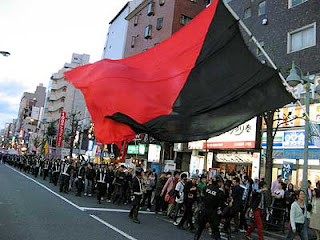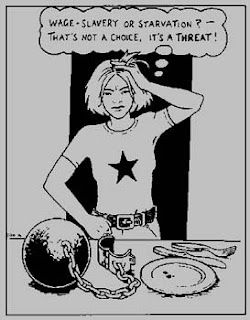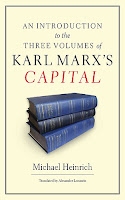Academics
 |
San Precario, patron saint of
all flex workers |
The notion of the precariat - derived from "precarity" and "proletariat" - has made quite a career. For a long time I was used to hearing it primarily in street demonstratons, but nowadays it has become academically respectable. I suspected that this might happen already when I read Guy Standing's 2011 book
The Precariat: The New Dangerous Class. But, still, I was quite stunned earlier this month, when I read in the news (
here) that a team of British sociologists had employed it in its analysis of the results of the BBC's Great British Class Survey of 2013. The "precariat", they declared, was one of seven classes in British society, the one that was most deprived in terms of economic, cultural and social capital. Towering above it were the other six classes: the elite, the established middle classes, technical experts, new affluent workers, the traditional working class, and emergent service workers.
The results featured prominently on
the BBC site, where the results were summarized by two of the team members, Mike Savage and Fiona Devine. Visitors to the homepage were also invited to take a simple test - in the "
Great British class calculator: What class are you?" - to see in which class they would fit in. Curiously, precarity of employment appeared to play no role as a factor in this class calculation. Neither, as far as I could see, was it much of a criterion in the survey analysis itself (see Savage et al 2013). The "precariat" is simply the label used for the category of people who score lowest on all forms of capital. Why then did they use the term? This, they state, was largely due to inspiration from Standing (ibid 243).

More than any other, Standing has paved the way for the academic respectability of the term precariat. Unlike the analysts of the BBC survery, he is careful to link the precariat to the global shifts in production processes that engender precarization. But very much like them, he sees the precariat as belonging to the bottommost rung of the class ladder (below the elite, salariat, proficians, and the old manual working class, and flanked by the unemployed and social misfits). Like them, he also stresses that members of the precariat are deprived in many ways apart from job insecurity: they lack work-based identity, career prospects, self-esteem and social worth, and are insufficiently integrated in society and community (Standing 2011:9, 12, 21f, for a summary see
Standing 2012).
While the definitions used by Standing and the analysts of the BBC survey are different, both locate the "precariat" at the bottom of the class ladder. Apart from suffering economic insecurity, members of the precariat are also prone to be socially isolated, culturally impoverished and lacking feelings of self-worth. This means that their notion of the precariat is rather narrow, since it leaves out a lot of people whose job situation is precarious but who might not be as deprived in other respects. To be sure, Standing acknowledges considerable variety in the composition of the precariat - which can contain migrants, people who drift into precarity from the "old" working class, as well as young people "over-credentialised for the flexi-jobs on offer". Still, as far as I can see the following groups would fall outside his notion of the precariat: students or young post-graduates (who may have careers), art workers (who often have a strong work-based identity or ”calling”), middle-aged dismissed workers (who also often have work-based identities), social withdrawers and mentally ill people (who often have support from families or institutions), day laborers (who again often have strong work-based identities), and many migrant workers (who may have communities supporting them).
 |
| Precariat or not? |
Activists
It is not my intention here to criticize these scholars, but I'd like to counterpose their use of the notion to another one - a notion more common among activists. The term precariat was not invented by Standing. Without citing any references, he claims that it was first used by French sociologists in the 1980s to describe temporary or seasonal workers (Standing 2011:9). Be that as it may, the term only gained wide popularity though the EuroMayDays beginning in 2004. At that time, no-one really seemed to know where the term came from, except that it was said to have originated as street graffiti in Italy in 2003.
The sense in which the term was used by the EuroMayDay activists was well expressed by Alex Foti.
Cross-cutting
traditional class boundaries, he wrote that it included “chain-workers” as well as
“brain-workers”, free-lancers as well as manufacturing temps. Unlike similar
terms, like “flex worker”, he stressed that the term carried strong connotations of political
agency: “The precariat is to postindustrialism as the proletariat was to
industrialism: the non-pacified social subject" (Foti 2004, 2005).
A striking trait of this notion of the precariat is that it cross-cuts class, rather than designating a class by itself. Rather than limiting the notion to the most deprived, an effort is made to invite students, artists, actors, and others in the knowledge industries to identify with the precariat. People can be in the precariat even if they score high on cultural and social capital, provided that they lead precarious lives. Why, one might ask, is the term is not limited to the most deprived? I think there are two reasons. Firstly, what Foti and other activists in the Euro Mayday tried to do was not to pinpoint a new stratum so much as to suggest how widely different stratas were affected by precarization in contemporary capitalism. "We are hirable on demand, available on call, exploitable at will, and firable at whim. We are the precariat" (Foti 2005). Secondly, they sought to use the term polemically, to help forge a sense of solidarity among those people. What mattered was not what strata you belonged to so much as your realization that neoliberalism had created your predicament.
To bring out a little bit more of how the term has been employed by activists, let me illustrate with some material from Japan, where the media activist Sakurada Kazuya was the first to popularize the term through events at the NPO Remo in Osaka in 2005 (see Sakurada 2006). It gained wide currency when a special issue on the precariat appeared in the journal
Impaction in early 2006. Soon afterwards it was picked up by the General Freeter Union (
Furîtâ zenpan rôdô kumiai), which used it for its May Day street party (the "Freedom and Survival May Day") in Tokyo the same year, the term's first appearance in a street demonstration in Japan.
 |
One of the early "Freedom and Survival May Day"
demonstratons (photo Mkimpo Kid?) |
As one activist in the General Freeter Union pointed out, part of the attraction of the term was that it had originated from the worker movement itself, not from the corporate world or academics: “The word ‘precariat’ differs from, for example, the word ‘multitude, since it didn’t come into being as an academic term but was born from anonymous wall-graffiti” (Settsu 2006).
Interestingly, in Japan, the term came to take on a wider meaning than in the Euro Mayday. Apart from people forced into a state of uncertainty because of the labour market, it has also come to include mentally and physically disabled, social withdrawers, wrist-cutters, the homeless, overworked regular workers and even small shop-owners. A good example of this wide definition is this forceful announcement of a street party in 2006, written by an icon of the precarity movement in Japan, Amamiya Karin:
You to whom living is hard, freeters, NEETs, social withdrawers, paupers, working poor, workers on the verge of death from overwork, temp workers, illegal overstayers, regular employees without insurance, you who long for suicide, all kinds of addicts, all you with physical or mental handicaps, wristcutters, or in other words: all members of the precariat – let’s roll out on the street and demonstrate! (Amamiya 2006)
It should be noted that “precariat” is only one in a "family" of similar terms used in the Japanese precarity movement. Some groups stick with terms like “good-for-nothing” (
dame) or “losers” while others prefer the simple “pauper” (
binbô). Others terms appearing from time to time are those of “rabble” (
uzômuzô), “desperados” (
narazumono) or “unstable poor” (fuantei hinmin), all connoting lowly social status as well as a heterogeneous composition.
 |
| Students protesting against high university fees |
The term precariat should, I think, be grasped in conjunction with these other terms. Common to them is, firstly, a self-deprecating humor lacking in the official or academic terminology. Secondly, the terms stress material and social deprivation, and imply identification with the underdog. Thirdly, they imply rebelliousness. Denigrating terms are taken over, but only to be turned into objects of polemical affirmation. When activists use terms like “losers” they are at the same time signaling their rejection of the value judgments inherent in it.
The polemical nature of these terms is connected to the fact that they so often appear fuzzy, ambiguous or paradoxical. To understand this, I think it is useful to recall Rancière’s suggestion that politics is quintessentially about “improper” names, or “misnomers”. According to him, the political act par excellence is what he calls subjectivation, an act whereby subaltern groups make themselves visible by polemically rejecting given identities, often in favor of new categories that appear unreasonable, “impossible” or paradoxical. Conversely, politics dies whenever groups submit to given, unambiguous categories, through what he calls “identification” (Rancière 1999). When demonstrators call themselves the “precariat” or “good-for-nothings” or “paupers”, then this is subjectivation, not identification. Flex workers may be submissive, but not the precariat.
To summarize, the "precariat" as used by activists differs from the academic notion by being used polemically by people recognizing themselves in it, instead of being imposed scientifically from above. It is not limited to the most down-trodden or worst-off, but is deliberately turned into a wide, elastic and ambiguous category capable of attracting many different kinds of groups and of being flexibly deployed according to the needs of the situation.
When academics like Standing or Savage et al use the term, there are few or no traces of the term’s activist roots and its subversive connotations. In their texts they seem to address a general non-precariat audience, without ever trying to get across to the people they refer to as the precariat. I am not accusing these academics of being apolitical or of aspiring to the impossible positivist dream of neutrality. As far as I know, they are progressive and probably even favorably inclined to the precarity movement. Standing, as is well known, has played an important role in promoting the idea of basic income. But the fundamental gesture of imposing a term from above remains - what Rancière saw as the provision of categories readymade for identification.

My intention is not been to criticize the academic usage of the term "precariat", but rather to throw light on the other, activist usage which also still exists. Maybe it's a good thing that the term has become academically respectable. But academics should be clearer than they are now about the history of how the roots of the concept were nourished in activism - roots which are still alive, and which mustn't be run over by terminological Juggernauts. I hope that the day will never come when activists who use the term will be told by academically inspired besserwissers that they are not the "real" precariat.
References
Amamiya, Karin (2006) “Demo da, demo da, mô sugu demo da!” [Demonstration coming soon], Sugoi ikikata, entry for 2006-08-01.
Foti, Alex (2004) “Precarious Lexicon”, pp 18-20, Greenpepper
Magazine (special issue: Precarity) 2 (Amsterdam, Greenpepper Project)
Foti, Alex (2005) “Mayday Mayday! Euro Flexworkers,Time To Get a Move On!”, EIPCP 04.
Rancière, Jacques (1999) Disagreement:
Politics and Philosophy, Minneapolis, London: University of Minnesota Press.
Sakurada, Kazuya (2006) “Purekariâto kyôbô nôto” [Conspiracy notes for the precariat], Impaction 151 (April): 20-35.
Savage, Mike et al (2013) “A New Model of Social Class?
Findings from the BBC's Great British Class Survey Experiment”, Sociology 47(2):219-250.
Settsu, Tadashi (2006)
“‘Purekariâto’ ni tsuite” [On the precariat], blog entry 2006-09-11.
Standing, Guy (2011) The Precariat: The New Dangerous Class, London: Bloomsbury Academic.












.jpg)







